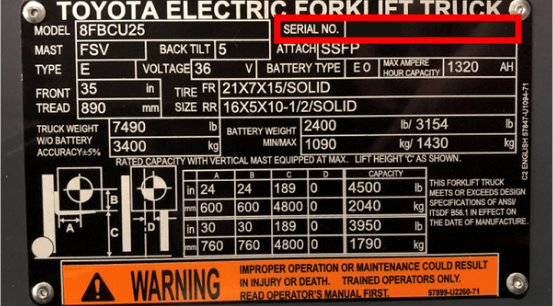Developing Proper Lockout Tagout Procedures

When a forklift is down and in need of repair, operators and managers are tasked with ensuring, first, the safety of those in their warehouse, and, second, that no further damage to the forklift or moved product occurs. When a forklift goes down, lockout tagout procedures should be initiated to help operators address both requirements simultaneously.
Lockout Tagout Procedures
What Does The OSHA Lockout Tagout Standard Refer To?
The OSHA Lockout Tagout Standard for The Control of Hazardous Energy (Lockout/Tagout), Title 29 CFR, outlines the required procedures for disabling machinery to help protect operators and other associates from unexpected bursts of energy or startup while maintenance activities are being performed on a piece of equipment.
Commonly, lockout tagout procedures included attaching a locked box to the forklift and a red and white warning tag hanging from the steering wheel. The box is a lockout box that isolates the forklift power source to the forklift so it cannot be operated and the tag provides information about why this forklift is locked out from its power source. Information you might see on the tag is the last date someone was working on the forklift, who last worked on the forklift, and the type of repair that is being performed. The procedure is meant to protect both the operators of the forklifts and the technicians performing maintenance on the forklifts. It’s to your benefit to fully understand this procedure as OSHA Standard 29 CFR 1910.333 requires lockout and tagout procedures be used on all equipment that uses electric energy for industrial purposes. This standard is meant to control hazardous energy such as electrical or hydraulic energy sources in forklifts. A typical lockout tagout procedure might follow these steps.
Lockout Tagout Steps
Step 1: Detail your procedure in full, including location
Step 2: Communicate the breakdown to ALL impacted associates
Step3: Shut down your equipment following detailed shutdown procedures
Step 4: Use lockout box or other procedure to interrupt energy output
Step 5: Follow procedures to eliminate any residual energy sources
Step 6: Attempt to start the equipment to make sure it will not start
Step 7: Perform maintenance
Step 7 b: Make sure to communicate breakdown across shifts
Step 8: Employ reverse lockout tagout procedures to reintegrate equipment into operation
To protect both operators and technicians, keep in mind these three tips about your lockout tagout procedure:
Understand That Removing the Key Is Not Enough
Removing the keys from the ignition is not enough to lockout your forklift. The forklift is still connected to the power source. It does not matter whether the forklift is powered by a liquid propane gas (LPG) tank or a battery, the hazardous energy is not isolated. Because the energy source is not isolated, there is potential for an unexpected release of energy, making both operators and technicians vulnerable to an accident.
Document, Communicate, and Train Lock Out Tag Out
Your lockout tagout procedure should be well documented. The documented process also makes it easier to communicate and train employees. If employees need clarity, the documented procedure is the first resource to turn to for answers. Once the procedure is documented, communicate the procedure and set up routine training to keep lockout tagout top-of-mind.
Inspect And Re-evaluate Procedures at Least Once Per Year
The success of your lockout tagout procedure cannot truly be assessed until the procedure is implemented. It allows you to gauge if the procedure is working, where improvements can be made, and how the procedure can change or evolve to become safer.
Lockout/tagout is meant to maximize safety in your workplace and these three tips will help you continue to improve your lockout tagout procedure. Need more information on lockout tagout? Check out this safety webinar from our outstanding dealer Toyota Material Handling Ohio.


